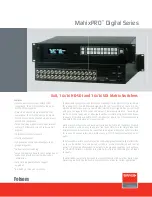
Operations Manual
59
If you are unsure of the base MAC address, it can be found either on a decal in
the proximate location of the RS232 port and/or on the Omega Diagnostics
submenu.
An ATM MAC address is created by adding the port number to the base
MAC address. For example, since the AT-4016TR has 16 10Base-T ports, it
would have 16 MAC addresses:
Port #1 — [basic MAC a 01]
Port #2 — [basic MAC a 02]
*
**
***
Port #16 — [basic MAC a 16]
Note that you do not have to assign a MAC address to every LEC if you use
the default ELAN. You can simply assign each LEC to the default ELAN.
Refer to the discussion “Default ELAN” on page 70.
Selector Byte.
The selector byte is used to denote specific ELAN
membership.
[network prefix] [MAC address]
[selector byte]
Selector bytes consist of integers ranging from 00 to 64 and includes a “Super
LEC.”
For example, a complete ATM address will resemble the following:
[network prefix] [MAC address] [00] — The “Super LEC”
[network prefix] [MAC address] [01] — LEC for ELAN #1
[network prefix] [MAC address] [02] — LEC for ELAN #2
*
**
***
[network prefix] [MAC address] [0x40] — LEC for ELAN #64
These ATM addresses are used to join ELANs 01 through 64 (hex 40).
Specifically, the 64 ELANs have ATM addresses with selector bytes ranging
from 01 through 64.
Super LEC
“Super LEC” ATM port address is not actually a LEC, nor can it join an
ELAN. “Super LEC” is only used to facilitate configuration requests.
For example, if a device shows up that has not been heard from before, a
configuration request will be sent from your switch to the LECS. This
configuration request will, in turn, be acknowledged as valid. It will have the
following ATM address as well as the MAC address of the device:
[network prefix] [MAC address] [00] — The “Super LEC”
















































